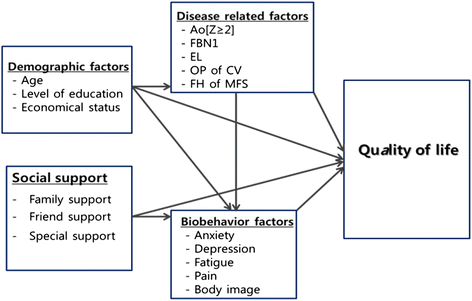Structural equation modeling of the quality of life for patients with marfan syndrome
- PMID: 27249938
- PMCID: PMC4890270
- DOI: 10.1186/s12955-016-0488-5
Structural equation modeling of the quality of life for patients with marfan syndrome
Abstract
Background: We used structural equation modeling to evaluate the quality of life (QOL) for patients with Marfan syndrome (MFS). The goal was to provide guidelines to facilitate the development of interventions and strategies to improve the QOL for patients with MFS.
Methods: The participants fulfilled the Ghent 2 criteria for MFS and they comprised patients who visited the cardiology outpatient department of a tertiary hospital in Seoul, Korea, between August 17, 2013 and April 17, 2014. Demographic, social support, disease-related factors, biobehavioral factors, and QOL data were collected in one-on-one interviews.
Results: The final analyses included 218 patients. Anxious and depressed patients comprised 63.8 and 71.5 % of the sample, respectively. For the hypothetical model, the goodness-of-fit index = 0.91, normal fit index = 0.93, and comparative fit index = 0.90. The outcome was suitable for the recommended level, so the hypothetical model appeared to fit the data. In patients with MFS, the QOL was affected significantly by social support, disease-related factors, and biobehavioral factors. These variables explained 72.4 % of the QOL in patients with MFS. Biobehavioral factors had the strongest and most direct effects on QOL.
Conclusion: To improve QOL in patients with MFS, comprehensive interventions are necessary to assess and manage biobehavioral factors, social support, and disease-related factors.
Figures


Similar articles
-
[Structural equation modeling on quality of life in pre-dialysis patients with chronic kidney disease].J Korean Acad Nurs. 2012 Oct;42(5):699-708. doi: 10.4040/jkan.2012.42.5.699. J Korean Acad Nurs. 2012. PMID: 23221659 Korean.
-
Executive function and quality of life in individuals with Marfan syndrome.Qual Life Res. 2018 Aug;27(8):2057-2065. doi: 10.1007/s11136-018-1859-7. Epub 2018 Apr 18. Qual Life Res. 2018. PMID: 29671248
-
Determinants of quality of life in Marfan syndrome.Psychosomatics. 2008 May-Jun;49(3):243-8. doi: 10.1176/appi.psy.49.3.243. Psychosomatics. 2008. PMID: 18448780
-
Cardiovascular characteristics in Marfan syndrome and their relation to the genotype.Verh K Acad Geneeskd Belg. 2009;71(6):335-71. Verh K Acad Geneeskd Belg. 2009. PMID: 20232788 Review.
-
Systematic review of quality of life in persons with hereditary thoracic aortic aneurysm and dissection diagnoses.Clin Genet. 2019 Jun;95(6):661-676. doi: 10.1111/cge.13522. Epub 2019 Apr 2. Clin Genet. 2019. PMID: 30788842
Cited by
-
Work participation in adults with rare genetic diseases - a scoping review.BMC Public Health. 2023 May 19;23(1):910. doi: 10.1186/s12889-023-15654-3. BMC Public Health. 2023. PMID: 37208707 Free PMC article.
-
Health-related quality of life and lived experiences in males and females with thoracic aortic disease and their partners.Open Heart. 2020 Oct;7(2):e001419. doi: 10.1136/openhrt-2020-001419. Open Heart. 2020. PMID: 33033116 Free PMC article.
-
A Review of Psychosocial Factors of Marfan Syndrome: Adolescents, Adults, Families, and Providers.J Pediatr Genet. 2019 Sep;8(3):109-122. doi: 10.1055/s-0039-1693663. Epub 2019 Jul 25. J Pediatr Genet. 2019. PMID: 31406616 Free PMC article. Review.
-
Health-Related Quality of Life in Children and Young Adults with Marfan Syndrome.J Pediatr. 2019 Jan;204:250-255.e1. doi: 10.1016/j.jpeds.2018.08.061. Epub 2018 Sep 27. J Pediatr. 2019. PMID: 30270167 Free PMC article. Clinical Trial.
-
Discussing psychological and psychotherapeutic support for patients with Marfan syndrome (MFS) and their family: an example of a structured program in Italy.Front Psychol. 2023 Jun 15;14:1176692. doi: 10.3389/fpsyg.2023.1176692. eCollection 2023. Front Psychol. 2023. PMID: 37397303 Free PMC article. No abstract available.
References
-
- Velvin G, Bathen T, Rand-Hendriksen S, Geirdal AǾ. Systematic review of the psychosocail aspects of living with Marfan syndrome. Glin Genet. 2015;87:109–16. - PubMed
-
- Peters KF, Kong F, Horne R, Frandcomano CA, Bisescker BB. Living with Marfan syndrome I. Perceptation of the condition. Glin Genet. 2001;620:273–82. - PubMed
Publication types
MeSH terms
LinkOut - more resources
Full Text Sources
Other Literature Sources
Medical
Miscellaneous

